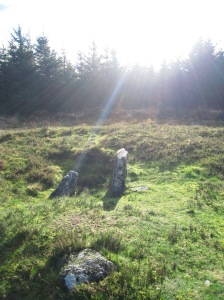I spent a week of November on Dartmoor, a place I cannot stop returning to. Each time I visit, I make tiny inroads to the vast wildness – this time I visited Bellever Forest/Lakehead Hill. I’d been to the outskirts of the place before but had been defeated by the quagmire of the forest. This time, I found the stony forest road and walked up through the middle of the trees. Like other parts of Dartmoor, it’s a conifer plantation that’s slowly being restored to native species. Unlike the other forest I’d explored (Fernworthy, near Chagford), Bellever has a benevolent atmosphere. We turned off the forest track, onto the Lych route, where the dead were transported years ago, and then up onto Lakehead Hill. Over the top of the rise, past the charcoal bog that threatened to suck one of my boots from my foot, lay a cist and a stone row. I saw a few walkers in the distance, making their way to Bellever Tor, but no one came near us and we sat by the cist in soulful peace for some time.

Our pilgrimage earlier in the year (Jhonn Balance’s memorial/Horsley village/Lindisfarne), to places of great personal and spiritual importance, were everything both myself and T had hoped they’d be, but our visits to various parts of Hadrian’s Wall failed to connect with either of us. On reflection, and after being on Dartmoor and at various local sacred sites in west Cornwall, it occurred to me that the energy at Hadrian’s Wall was essentially very male, whereas the prehistoric sites I usually go to have a female energy. Ironically, the only part of the Wall I did connect with was the Temple of Mithras, set amongst the moors and the curlews, apparently a place exclusively for men to worship at.

